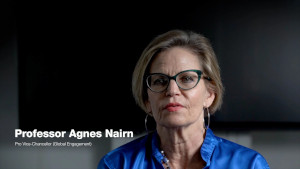Prof. Agnes Nairn, Co-Director of the Bristol Hub for Gambling Harms Research, and Dr. Raffaello Rossi, Hub Communications Lead, feature in this impact story for the University of Bristol Business School about their research into protecting children from the harmful effects of gambling advertising on social media. The full story can be read below, or by following this link.
Gambling problems in children
If you’ve never heard of skin gambling, loot boxes or matched betting, try asking the nearest teenager. In fact, these are all ways in which children and young people can be lured into online gambling.
 The number of UK children with gambling problems has quadrupled to more than 50,000 in just four years. With the opening of child gambling clinics to tackle rising rates of problem gambling, the NHS and government have recognised this serious and growing issue. Indeed, the manifestos of all main political parties at the last general election pledged to tackle gambling regulation as a priority. There are strict regulations regarding advertising for online gambling, but for a few reasons, these are not always being followed when it comes to social media platforms.
The number of UK children with gambling problems has quadrupled to more than 50,000 in just four years. With the opening of child gambling clinics to tackle rising rates of problem gambling, the NHS and government have recognised this serious and growing issue. Indeed, the manifestos of all main political parties at the last general election pledged to tackle gambling regulation as a priority. There are strict regulations regarding advertising for online gambling, but for a few reasons, these are not always being followed when it comes to social media platforms.
The role of advertising
Focusing on the role advertising plays in these developments, research by Professor Agnes Nairn and Dr Raffaello Rossi investigated the effects of social media gambling ads on children and young people. Their first research project with Ipsos MORI and Demos focused on gambling ads on Twitter.
Using big data analytics of over 880,000 UK gambling ads, along with data of 1,000,000 users, they found that:
- 41,000 UK children follow Twitter gambling accounts
- two-thirds of engagements with these ads were made by under 24-year-olds
- the big UK gambling brands post around 29,000 ads per year
71% of gambling ads failed to fully comply with regulations set by the Advertising Standards Authority (ASA).
 Esports, a form of competitive video gaming, that predominantly attracts amateur and professional players in their early 20s or younger, was of particular concern. The research offered novel insights into esports gambling adverts, highlighting the stark difference between these and traditional gambling (such as football betting) and their strong appeal for children.
Esports, a form of competitive video gaming, that predominantly attracts amateur and professional players in their early 20s or younger, was of particular concern. The research offered novel insights into esports gambling adverts, highlighting the stark difference between these and traditional gambling (such as football betting) and their strong appeal for children.
This research was published in Biddable Youth, a major report by the University of Bristol Business School and the Centre for the Analysis of Social Media at Demos. The report formed part of a much larger research project funded by GambleAware, aiming ‘to assess the extent, nature and impact of gambling advertising on children, young people and vulnerable groups in the UK.’ Some of the results were also published in an academic paper in the top peer-reviewed Journal of Public Policy and Marketing.
The initial study aimed to understand the ecosystem of gambling ads on Twitter, this presented some serious concerns surrounding the potential effect the ads on children. As a result, Nairn and Rossi moved on to a second study, to examine whether children and young people find gambling advertising more appealing than adults. Conducting an online experiment withover 650 participants aged 11-78, the research found that gambling advertising on Twitter is strongly and significantly more appealing to children and young people than to adults. Esports ads and ads using content marketing (a form of stealth advertising that is harder to recognise) were found to be especially appealing, triggering happiness, excitement and delight in under 25-year-olds.
A lack of awareness
 Agnes Nairn, Professor of Marketing at the University of Bristol Business School, says that the lack of awareness about this trend is a real problem: ‘Parents don’t have a clue about esports at all. And if they do, they don’t know about the gambling that goes alongside it. So, they’re not likely to be talking to their kids about it, in the way they might talk about online poker or regular sports gambling.’
Agnes Nairn, Professor of Marketing at the University of Bristol Business School, says that the lack of awareness about this trend is a real problem: ‘Parents don’t have a clue about esports at all. And if they do, they don’t know about the gambling that goes alongside it. So, they’re not likely to be talking to their kids about it, in the way they might talk about online poker or regular sports gambling.’
As with many other technology sectors, esports is developing faster than its regulators can move to control it. There are rules that should prevent esports betting advertisers from targeting children and young people such as disallowing the use of images of under-25s in gambling adverts. However, Professor Nairn found they were being flouted time and again: ‘Most of the superstars in esports are under 25. When you show a picture of them in a betting promotion, you are already breaking regulations.’
A further concern was that, of the 888,000 tweets sent by betting-related accounts that were examined using computer-aided analysis, only 7.3% were found to contain any warning about the minimum age for gambling, responsible gambling, or terms and conditions in the text. For esports accounts, this number fell to just 0.1%, displaying the very worst in advertising practices.
There is also an issue with the time of day these tweets are posted, Professor Nairn explains: ‘There are huge esports communities in China, South Korea or the USA, meaning that although this may not be a strategy, children are seeing esports bookmakers’ tweets posted in the middle of the night here in the UK.’
Manual content analysis by the researchers found that 17% of esports tweets encourage betting late at night or in the small hours. Separate research has shown that esports marketing late at night is more likely to effect vulnerable users and make them spend more.
Strong appeal to children
 Dr Raffaello Rossi said: “The overwhelming strong appeal of gambling advertising on social media to children is of huge concern, as the earlier people start gambling the more likely it will become habitual and problematic.
Dr Raffaello Rossi said: “The overwhelming strong appeal of gambling advertising on social media to children is of huge concern, as the earlier people start gambling the more likely it will become habitual and problematic.
“That’s why there needs to be much stricter and clearer rules in place to clamp down on the issue, which could easily spiral out of control given how long children and young people spend on social media these days. Many of the adverts may look entirely innocent and harmless, but they in fact pose a serious risk of getting a whole new generation of gamblers hooked on a serious addiction which has devastating consequences.”
Recommendations
The research contains several recommendations, aimed at industry and advertisers, technology companies, and regulators. These include:
- Making existing age verification tools available to all advertisers.
- Integrating more explicit references to age restrictions and safe gambling in advertising content.
- Ensuring existing regulations and best practices in regard to licenced betting are followed.
- Considering the potential value of education initiatives for parents and young people.
- Esports gambling advertising, which automatically appeals to children and young people, should be banned.
- Gambling content marketing, which masquerades as something appealing, to be rigorously regulated and informed by what is proven to attract young people.
- Regulators to broaden the age range of a ‘young person’ from 16-17 to 16-24-year-olds.
- Social media platforms to only allow gambling ads on social media when users actively opt-in to receive them.
Professor Nairn is pleased with the response so far. ‘We’ve had really good dialogues with the Advertising Standards Authority,’ she says. As a result, they have changed the regulation that stipulates that gambling adverts should not be “of particular appeal” to children (i.e. more appealing to children than adults) to “of strong appeal”. This is a breakthrough because under the previous regulation, an advert could be extremely appealing to children (for example something related to premier league football) yet not prohibited just because if was equally appealing to adults.’ Beyond this, Dr Rossi said: ‘It is great to see that the advertising regulator is taking our work seriously – they have now included content marketing in their remit – a big breakthrough.’
Impact
Beyond receiving substantial national and international media coverage, the researchers were invited to give evidence to the Department for Digital, Culture, Media & Sport (DCMS), the National Digital Ethics Expert Group by the Scottish Government, and the House of Lords’ Peers for Gambling Reform. The research was extensively debated in the House of Lords, repeatedly mentioned in House of Commons, and cited in the DCMS Gambling Act Review White Paper.
 The research led to three direct changes in current advertising regulations: First, a public consultation into the appeal regulations that should protect children from harm via gambling ads was announced by the ASA in response to the research findings. The consultation led to updated and clearer regulations to improve the protection of children.
The research led to three direct changes in current advertising regulations: First, a public consultation into the appeal regulations that should protect children from harm via gambling ads was announced by the ASA in response to the research findings. The consultation led to updated and clearer regulations to improve the protection of children.
Second, an advice notice clarifying the regulations for esports betting advertising has been published by the advertising regulators.
Finally, the ASA has addressed a loophole raised by Nairn and Rossi; namely, that content marketing (a form of advertising very appealing to children) was not in their remit. Following the research, the ASA announced a change in position, such that all content marketing is now in remit – not just for gambling, but for other products and services too, creating an important change in how social media ads are regulated.
In addition to Bristol offering advice to UK organisations such as the ASA, international interest in the report has resulted in invitations to speak to European and Asian audiences. ‘There are very different views about gambling in different countries,’ says Professor Nairn. ‘This makes it a very rich area to consider internationally: there’s a lot of mileage in it yet.’

